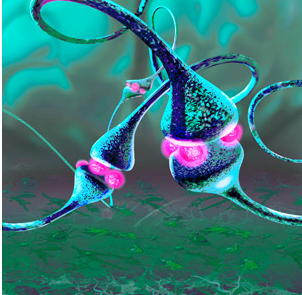Something is common in Trees and Human: Change to Adapt
As we know the cell is the basic structural, functional, and biological unit of all known living organisms. The number of cells in plants and animals varies from species to species but humans contain about 100 trillion cells.
Since our bodies are huge masses of atoms we can generate electricity. Protons have a positive charge, neutrons have a neutral charge, and electrons have a negative charge. When we talk about the nervous system sending ‘signals’ to the brain, or synapses ‘firing’ or the brain we’re talking about electricity. It is the electrical signal which carries messages between point A and point B.

(Craig Zuckerman/Visuals) http://health.howstuffworks.com/human-body/systems/nervous-system/human-body-make-electricity.htm
According to the scientists we are not the only one who uses electrical signals to communicate between cells inside the organism.
Humans aren’t the only one in electrical signalling
When Mimosa leaf induces electric signals, many other plant cells surprisingly realize this communication. Regulating the electrical charges in order to adapt the new situations is very common amongst plants.
There is tactile signalling (externally circumstanced) makes the plant to adapt the current conditions. Prof. Daniel Chamovitz explains that phenomenon as: “plant responses to tactile signalling over 2% of the 25.000. Arabidopsis (thaliana) genes are activated when you touch a plant. When an animal brushes up against it or even when the wind shakes its leaves as well. A plant rooted in the soil has to respond to multiple ways in order to modulate its growth, its own physiology. It’s an adaptation to survive in a changing environment is impressive” Also in Venus flytraps, closes when a pray gets in, by the help of electrical charges in the membrane. That helps the plant to depolarize ions. The release of calcium ions in response to the depolarization is very similar to what happens in neural communication in humans.” The electrical mechanism allows plants for short term memory and our brains work also electrical potentials one of which involves also in human short term memory.
Thigmomorphogenesis
Jovanov and Alexander G. Volkov has mentioned in their article on Plant Electrostimulation and Data Acquisition a similar thing. ‘‘Monitoring the electrical signaling in higher plants represents a promising method to investigate fast electrical communication during environmental changes.’’
Plants are known specifically sensitive even for a small change of temperature like cold, warm or any type of weather conditions.

In that picture simply we see two same types of a tree. The first one lives in the valley has relatively shorter branches. The one on the left side, top of a mountain, find ways to sustain its own survival. The one which is relatively longer branches exposed to a strong wind. It must have adapted some skills by transforming the mechanic sensitive stimulations into information by leaning branches to one side.
Sometimes natural changes effects on animal behaviours too. Like changing day length affects a bird’s pituitary gland causing it to secrete hormones that control avian behaviour. Short autumn days elicit a ‘wanderlust’, ultimately leading to migratory behaviour.
Plant Biology To a Complex Human Structure
Electrical Signalization in Plants and Brain Neuron Synapses In Humans
That signalization contextual transfers the information of external conditions is much more complex in animal cells than in plant cells. How these adaptation skills have been developed in order to make the survival possible is still a subject of researches.
The information transfer by the help of genes and chemicals makes humans also to survive in different circumstances. The scientists have discovered that there is a big connection to human responses like in plant cells. Calcium regulates electrical charge and communication between the cells of a plant by binding a very important protein called calmudilin. In plant cells Calmodulin activates electrical charges simply by touching it such as by wind shaking.
The Importance of Calcium
Calcium is equally important for animal cells for memory, for information, for muscle function and for nerve growth. Without any doubt, human anatomy is more complex than plant anatomy. As we know in our bodies Neurons communicate with each other using electricity and chemicals. The nervous system consists of the brain, spinal cord, and a complex network of neurons. This system is responsible for sending, receiving, and interpreting information from all parts of the body. The nervous system monitors and coordinates internal organ function and responds to changes in the external environment. This system can be divided into two parts. First the central nervous system second the peripheral nervous system. Motor neurons carry information from the central nervous system to organs, glands, and muscles. Sensory neurons send information to the central nervous system from internal organs or from external stimuli. Interneurons relay signals between motor and sensory neurons.
Instantly, the structure of our Brain Changes
Whenever we dream, laugh, think, see, or move tiny chemical and electrical signals are racing between these neurons. That happens along billions of tiny neuron highways. Countless messages zip around inside it every second like a supercharged pinball machine. Our neurons create and send more messages than all the phones in the entire world. While a single neuron generates only a tiny amount of electricity, all our neurons together can generate enough electricity to power a low-wattage bulb. Signals along certain pathways of neurons over and over. They are forming new connections. In fact, the structure of our brain changes every time we learn, as well as whenever we have a new thought or memory.

According to Dr. Pascale Michelon Neuroplasticity (brain plasticity) refers to the brain’s ability to change throughout life. The brain has the amazing ability to reorganize itself by forming new connections between brain cells. New connections can form and the internal structure of the existing synapses can change. In 2007 Psychiatrist and psychoanalyst Norman Doidge, M.D. wrote a book on that matter. It is called The Brain That Changes Itself: Stories of Personal Triumph from the Frontiers of Brain Science.
Adaptation to change is inevitable
‘‘Environmental effects on human physiology are numerous. One of the most carefully studied effects is the alterations in thermoregulation in the body due to outside stresses. This is necessary because in order for enzymes to function, blood to flow, and for various body organs to operate, the temperature must remain at consistent, balanced levels.’’
‘‘Living things need to ‘fit’ into their surroundings, to ensure survival. An adaptation is an inherited characteristic that helps an organism survive and reproduce in its environment. Sometimes adaptations are learned during the organism’s lifetime.’’ Animals inherit many kinds of adaptive behaviour. ‘‘In general, adaptations can be structural (meaning an organism undergoes bodily changes to survive). Or it is also known as behavioural (when a specific behaviour increases an organism’s chances of survival).’’ Animal migration is an example of a behavioural adaptation.
Mutation
In nature adaptations usually occur because a gene mutates or changes by accident. Some mutations can help an animal or a plant to survive better than others in the species without the mutation. An example of a structural adaptation is the way some plants have adapted to life. In the desert hot and dry places especially. For plants called succulents, for instance, have adapted to this climate by storing water in their thick stems and leaves.
According to one aspect of cause to adaptation in humans is mainly thanks to using the technology. We design and build better air conditioners, warmer parkas, better diving suits, and lights to see in the dark. Technology lets us adapt quickly to changes in our environment. However, for other animals, adaptation is a slow, steady process which may take hundreds of thousands of years to accomplish.
Mindfulness Based Meditations & impacts on Human Brain
Thanks to the Electro-encephalogram (EEG) today we can make experiments on how the brain works. For instance, 128 sensors pick up tiny electrical signals emitted as brain cell works less when we are relaxed and the eyes closed. The pattern that the brain produces by the help of all this small activity of doing nothing we can clearly see that the brain is still active. As soon as we open our eyes this time the brain leaps into a big action mode which makes it work much more sophisticatedly.
Every one of us needs short breaks during the day. That helps our brain to breath. Some type of meditation also help. If you start exercising, your brain recognizes this as a moment of stress. As your heart pressure increases, the brain thinks you are either fighting the enemy or fleeing from it. To protect yourself and your brain from stress, you release a protein called BDNF (Brain-Derived Neurotrophic Factor). This BDNF has a protective and also reparative element to your memory neurons and acts as a reset switch. Sometimes we need to reset or other words switch off our brain activity. Just feeling calm and quiet is enough. We need to simply sit and try doing nothing.
Psychology and Human Brain
There are a lot of tools available for us to protect our brain health and psychology. In particular against daily unwanted loads. Daily routines happen in highly rapid changes in our surrounding. Mindfulness type meditation practices would be very useful to grow and survive. Meditations need our full attention. Our minds simply observe what sort of tendencies it makes. This observatory position is the essence of acceptance. Like my trainer, Vin Harris has mentioned the fact that ‘‘mind has its own life’’. It charges electrical activity all the time.
By the nature of the human brain carries or accumulates different electrical charges during the day. These charges may have given negative or positive impulses to our body. Neuropsychiatric disorders associated with early life adversity may involve neural changes. It is reflected in EEG power as a measure of brain activity and disturbed sleep.
8-week Mindfulness-Based Stress Reduction (MBSR) Program at the University of Massachusetts gets some results on Meditation groups. Participants reported spending an average of 27 minutes each day practising mindfulness exercises indicated significant improvements compared with the control group. The analysis of MR images focused on areas where meditation-associated differences. It is found that the brain increased grey-matter density in the hippocampus. This part is known to be important for learning and memory, self-awareness, compassion and introspection.
Meditation helps
Participant-reported reductions in stress and decreased grey-matter density in the amygdala. This part is known to play an important role in anxiety and stress.
According to Psychiatry Research Journal Anatomical magnetic resonance (MR) images from 16 healthy meditation-naïve participants, grey matter concentration was high. It is investigated in using voxel-based morphometry, compared with a waiting list control group of 16 individuals. Grey matter concentration within the left hippocampus shows that the brain increases cingulate cortex and grey matter concentration. Some brain regions involved in learning and memory processes, emotion regulation, self-referential processing, and perspective-taking. At least 20 more other scientific effects you may find thanks to meditation. That includes pain management, better sleep, control of emotions etc. None of these changes was seen in the control group.
Conclusion
Having difficulties or behaving in social changes impacts us deeply and we end up with a big need for adaptation skills. Adaption is vital to surviving as we see in all living things.
It would be important also to underline the fact that the human brain which is charged many times higher than a less sophisticatedly structured plant, needs more manoeuvres to improve its skills to discharge in order to adapt its days and environments. But we are not the only one who charges electrical signalling and search for change to adapt better.


